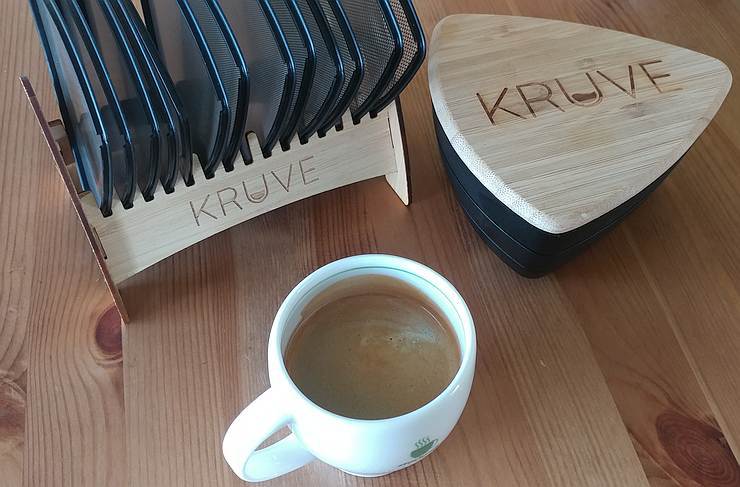
Do you really need a ground coffee sieve at all? No, you don’t need it if you own a $700 grinder. You also don’t need it if you can’t distinguish an espresso from a drip coffee. However, if you want to improve your coffee taste, and to get consistent results, you need it. I’ll show you in a bit why most grinders on the market are just not good enough. We also have a review of one of the best sifters on the market, the Kruve.
Why Do We Need Consistent Grind Size
One of the biggest problems with coffee extraction is the grind size consistency. There are a couple of problems with uneven grinding:
- Extraction
- Filtering
Extraction time and temperature are in a direct correlation with the grind size. With a fine grind size, we need a shorter extraction time and a lower extraction temperature. When we grind coarser, we need to adjust those values by increasing the water temperature and prolonging the brewing time. This is valid for almost all brewing methods.
Average grinders will give you a dust and boulders grind. The grounds will have a considerable amount of undesirable particle size. With boulders and dust, your extraction time and temperature will only be good for part of the grounds. The rest of the grounds will be over-extracted, or under-extracted, depending on your parameters.
Let’s take a real-life example, an espresso shot. You grind your dose for espresso and 70% of the particles are your desired grind size, and the rest is dust-like. The 70% correctly ground will extract properly, while the 30% that is too fine, will be over-extracted giving your shot a bitter taste. The same goes for French press, or AeroPress, or drip, but for these methods, we have another problem – filtration.
Filtering the brewed coffee is an important step in coffee preparation. Most coffee lovers are seriously put off by the sediments in the final cup. This is obvious for a French press, or permanent filter methods, (Kone, or automatic drip with metal filter). But paper filter methods suffer from bad grind as well. Yes, the paper filter should be able to retain the dust, and that is good. But is at the same time bad, because the fine particles clog the filter, slowing down the flow. You will end up with an over-extracted drip coffee because the extraction time will extend.

Cold Brew and Inconsistent Grind Size
One particular case is cold brew. You would think that given the low brewing temperature, there should be no concern about uneven particles. And you are right if you thought of that. The problem with cold brew is the filtration. The dust in the grounds is passed on almost entirely in the coffee concentrate, making your cold brew silty. Why is this important? Two reasons, you can save some money by using a finer grind. Also, you can brew faster. Here is why: The general consensus on cold brew is to use coarse grounds. This is because you want to avoid the silt in your cup, and the finer you grind, the more dust you get. By using a consistent particle size, all of the dust is eliminated from your cup. Check my post about the fast cold brew technique.
Ground Coffee Sifters
Hoping I wasn’t too boring with the technical stuff, I’ll get to the point: ground coffee sifters. The coffee sieves are the easiest way to ensure a consistent particle size. You can use a sifter even if you have a high-end coffee grinder. Perfectionists will find that even the best coffee grinders can produce some dust, and the only way to eliminate that is to sift it.
A ground coffee sifter is a precision device, that sorts and separates coffee particles by size. The sifter uses a system of multiple screens to separate the particles. In practice, 2 to 3 screen sizes used for a batch are more than enough to retain undesired particles.

Kruve Coffee Sifter Review

You can find the Kruve system on Amazon: Sifter Six Pack.
Kruve sifters range from 200μm to 1600μm. The range includes a fine range, from 200μm to 400μm in 50μm increments, that gives us 5 sifter sizes. It also includes a medium to coarse range, from 500μm to 1100μm in 100μm increments, for a total of 7 sifters. For those who wish to experiment with extra-coarse, there is the XL pack with three sifters, 1200μm, 1400μm and 1600μm.
Kruve comes with a lid and three trays. The three trays allow a great particle separation for most needs. If you need more than 3 trays, you can probably do it in a two steps sequence, but you should consider buying a better grinder. My brewing test further down the page will show you why you need a decent grinder and not an average one.
Here is my review of the Kruve system:
- The set is made with a great attention to detail, and it just feels right in use.
- The screens are made from high-quality steel, with precision cut holes.
- They are flexible, yet they are not flimsy and snap firmly into the trays, grace to the rubber padded rims.
- The trays fit snugly and they are easy to handle during the shaking.
- The set contains every possible sieve size, and you can purchase them as needed. (Total of 15 screen sizes)
- The lid feels nice, I wish it was thinner though.
- The screen holder looks nice. It took me a few minutes to assemble it, because the holes were a little too small. I think it’s a good thing in the end because this makes it sturdy.
How Kruve Improves Your Coffee
French Press Recipe and Test
Let’s take French press brewing for instance. The influencers in the industry tell you to use the coarsest grind size. In a way they are right; any finer grind size setting will result in a lot of dust. French press is not renowned for a good filtration system, hence a lot of particle suspensions in your final cup. With a set of sifters, you can eliminate both the boulders and the dust. When you eliminate the dust, you can grind a little finer, because you know that particles are not going to pass through the screen. When you grind finer, with any coffee brewing method, you have two benefits. Firstly you are going to increase the TDS without extra cloudiness, secondly, you can use less coffee, because the extraction is more complete.
Kruve recommends using the 1000μm and the 600μm screens for a French press. The very coarse particles, larger than 1000μm will stay on the top tray. The good stuff, the particles between 600 and 1000μm will collect in the middle tray, and this is what you are going to use for your French press. The fines are going to collect in the bottom tray, and you can probably grind them further and use them for a Turkish coffee, or you can re-sift them for espresso.

The result is an amazing cup, with ample body, and beautiful flavor, and perfectly clean. You would think that the fine grind causes the grounds to pass through the screen. Not at all. No trace of silt, or grit in my cup. This is because the screen is fine enough to retain a medium grind. The problem is with an uneven grind, where we have both boulders and dust. The boulders are under-extracted, and the dust is over-extracted, and it slips through the screen/filter.

My tip for the sifted French press is to calibrate your grinder finer than you usually do, and let the Kruve do its magic. Stir vigorously, aiming to make all grounds sink at the bottom of the beaker. When properly saturated with water, the grounds will expand in volume, and will not pass through the screen. You need to experiment, because results may vary. This is determined by your grinder and the quality of your French press. Sometimes the beans origin and the roast level can affect the grind.
Espresso Recipe and Test
I am an espresso lover, and my espresso brewing guide is one of the geekiest. I enjoy French press from time to time, but my daily routine is espresso. As such, I wanted to experiment with sifted espresso. I heard about sifted espresso before, but the main reason was not the grind uniformity. People who played with sifting were trying to merely avoid the clumps in the basket. Our test was going to deal with both clumps and grind size. I was pretty excited. The result was a surprise, even after my great success with the French Press. It’s common knowledge that consistent grind is key to a great shot. I have said it too many times on this blog, so here we are one more time: consistent grind. Your grinder, even the expensive ones, will not give you a uniform grind. For this test, I used my Baratza Vario grinder, which is normally used as part of my daily espresso routine. I pulled one shot without using the Kruve, and one with sifted grounds. Take a look at the pictures below and be the judge of it.
The regular shot was good, I was expecting that, nothing new about it. The sifted shot was amazing. It had more crema, it was slightly sweeter, and had none of the silt the original cup had. Subsequent shots showed me that I could tamp a little harder on the sifted grounds, and the flow rate will be under 30 seconds total extraction time. The results made me dream about predictably pulling God shots. Am I fooling myself? Time will tell. In the meantime, you can try yourself and share your experience.
















